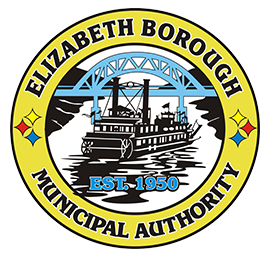Wastewater is conveyed to the Sewage Treatment Plant from the Elizabeth Borough Pump Station or the Elizabeth Township Wylie Run Pump Station. The two pump station operates entirely independent of each other.
At the Elizabeth Borough Pump Station, sewage flows through a bar screen and channel monster which reduces rags and large debris. A grit classifier removes the smaller particles know as grit prior to the raw sewage pumps. These pumps deliver the sewage to the treatment plant through approximately 800 feet of an 8” inch diameter asbestos-cement force main.
At the treatment plant, the wastewater flows through a comminutor and bar screen to further remove any rags or debris before it enters the treatment process.
Next it flows to the aerated grit chamber to further remove any sand, gravel, etc. Then the wastewater flows to the aeration tanks to begin the active sludge process for the removal of soluble BOD and nonsettleable substances. The aeration tanks is where the aerobic bacteria meets the wastewater, where biological treatment occurs. The aeration tanks provide a source for oxygen, food and mixing for the bacteria. By the time the wastewater leaves the aeration tanks, the aerobic bacteria has used the organic matter contained in the wastewater to produce more cells. Aeration times vary due to the amount of wastewater flow entering the plant.
In the next step, wastewater flows into the clarifiers allowing organisms to settle out to the bottom and separate from the clear water. These settled organisms are known as sludge. The sludge that accumulates at the bottom of the clarifiers, known as return activated sludge (RAS), is then pumped back to the aeration tanks where it again mixes with the incoming wastewater (food source) and continues the treatment process. Some of the return activated sludge is removed from the treatment process because it is excess. This waste activated sludge (WAS), is removed thorough a process called wasting and sent to an anerobic digester before final disposal.
The clear water that remains is called effluent. It flows from the clarifiers to the chlorine contact tanks for disinfection. Chlorine is then mixed with the effluent to kill any remaining bacteria or microbes for the treatment process. Once the effluent leaves the chlorine contact tanks, it is then discharge to the Monongahela River.
